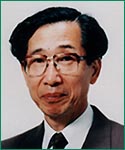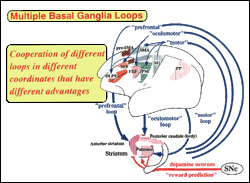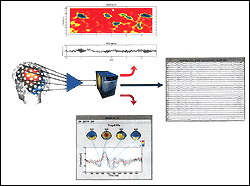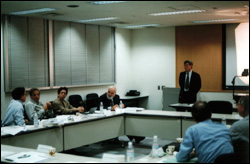  |
 |
 |

|
The New Perspective of the Brain-Style Information Systems Research Group
| Dr. Shun-ichi Amari |
| Group Director, Brain-Style Information Systems Research Group |
| Head, Laboratory for Information Synthesis |
|
 |
The Group's Origin
The Brain-Style Information Systems Research Group was launched in October of 1994 as an institution specializing in creating the brain , under RIKEN's Frontier Research Program (FRP). As an institution for conducting a new type of theoretical research on the brain within the framework of RIKEN, the group's aim was to bring about an overall yet dramatic change in this field in Japan, in coordination with an experimental research group.
The group consisted of three laboratories, and still does today. As the laboratory leader, I worked on getting my team started while working at the University of Tokyo for the first 18 months. The other laboratory heads were Dr. Shigeru Tanaka, who had worked with NEC as a theoretical brain researcher, and Prof. A. Cichocki of Poland. In the group's early years, most of the researchers were foreign nationals, and the fact that the atmosphere of our workrooms was like an international community is still fresh in my memory. Our group still retains this tradition, with non-Japanese researchers accounting for all but half of the staff.
I was assigned to head the Laboratory for Information Representation in FRP, which was to conduct theoretical research on the neural network mechanism and mathematical algorithm of the brain in order to clarify the process of information representation in the brain. The Laboratory for Neural Modeling led by Dr. Tanaka aimed at studying, with a theoretical approach, the structure of the neural network of the brain in its entire phases, including emergence and growth. The laboratory's ultimate objective was to specify the underlying information processing mechanism of the brain by combining theoretical findings with experimental verification. Dr. Cichocki's Laboratory for Artificial Brain Systems was to explain about the synthetic intelligence capacity of the neural network with an aim at directing its finding towards the development of a new generation of information processing by means of engineering technologies.
|
 |
Group Reform and International Research Review
Right after the group was started we did not have any permanent laboratories, and relocation was not unusual. Things changed when a fresh move emerged towards the reinforcement of brain science research as part of the national strategy for the 21st century. Talks went on for reinforcement of the existing scope of research, and soon three research areas, namely, Understanding the Brain , Protecting the Brain and Creating the Brain were on the table. Additionally, in order to attain maximum coordination between the three research areas, a plan was unveiled to establish a Brain Science Institute (BSI) within RIKEN as the nation's central facility for frontier research.
BSI was inaugurated in October 1997, and our group became part of the new institution. I was involved in getting our laboratory started anew as the central facility for the creation of the brain. The three laboratories were renamed Information Synthesis, Neural Modeling, and Open Information Systems laboratories. While nothing changed in our research itself, the inauguration of a Brainway Group under Director, Dr. Gen Matsumoto put our target of creating the brain into sharp focus.
Four years after the start of our research, a research review took place this February, as was originally scheduled. An international Research Review Committee (consisting of six foreign and three Japanese members) was organized for BSI's first and full-scale job review. The international assessment of our achievements and valuable advice from committee members was quite helpful for us in charting our future course. Yet the review was an acid test for us, for a bad mark could have ended our research.
|
 |
Activity of Individual Laboratories
The Laboratory for Information Synthesis has tried for four years to find the underlying principle of information processing in the brain with the ambitious aim of launching a brain-style mathematical information science. The laboratory has successfully specified the extent of competence and peculiarity of the neural network for information processing, by means of information geometry, a new mathematical approach established in Japan. Additionally, it has proposed a highly efficient and theoretically endorsed algorithm of neural learning. These achievements have undoubtedly raised Japan to the top among nations of the world in the field of brain-style mathematics. The laboratory's research activity is directed towards brain mechanism as well. Study is under way in coordination with experimentalists to clarify the mechanism of the hippocampus and basal ganglia and to explain the pulse representation of information in the brain. The laboratory is also involved in the study of independent component analysis. There is no doubt that BSI is now one of the key institutions in the world in theoretical research of the brain.
The Laboratory for Neural Modeling, during the course of its theoretical research on the fundamental pattern of the column structure in the cerebral cortex, has discovered that a mathematical structure called homotopy plays a significant role in this peculiar mechanism. The laboratory has taken a theoretical approach to work out a new method of experiments for verification of the theoretical column structure, particular in the early phase of its development. Subsequently, it started actual physiological experiments with the aid of optical recording and achieved encouraging results. For theoretical researchers, conducting experiments by themselves requires extraordinary courage. In this sense, their experiments are worth the highest praise as a significant step forward in filling the existing gap between theory and experiment.
The Laboratory for Open Information Systems has placed an increasing emphasis on its fresh approach to brain data analysis while continuing its study of brain-style parallel calculation and chaotic dynamics. The brain data that is under study ranges from multi-electrode records and EEG, MEG and other records of electromagnetic fields generated by brain activity, to direct images of brain activity such as fMRI and optical records. While a new analytic method called independent component analysis is attracting keen international attention, this laboratory has joined forces with the Laboratory for Information Synthesis to unveil an even more effective approach to the new analytic method. Its proposal has aroused renewed international attention as an impressive upgrade.
|
- |

Information processing model of the cerebral
cortex and basal ganglia
[Lab. for Information Synthesis]
|

The neurons in the visual cortex respond selectively
depending upon the orientation and motional direction
of objects, and the nearby neurons tend to present
similar response properties.
The figures show the patterns of the orientation
column (A) and direction column (B), which were
obtained from the same region in the area 18 of the
catby using the optical recording technique.
The bars and arrows below figures (A) and (B)
represent the correspondence between the colors
and the optimal orientations or directions, respectively.
The length of the scale bar represents 1mm.
[Lab. for Neural Modeling]
|

Multi-sensor processing, analysis and synthesis
of brain signals in time and time frequency domain.
[Lab. for Open Information Systems]
|
 |
Evaluation by the Research Review Committee
These are but a few of our comprehensive research activities. In order to provide the Research Review Committee members with a full knowledge of what we have attained, we supplied detailed data prior to the committee meeting. The data helped minimize the time for the committee's critical examination, allowing for meaningful discussion at the meeting.
The Research Review Committee's report was satisfactory to us. It came up with a fair evaluation of our research results, particularly in view of their status and contribution in a global perspective. Japan has pioneered the establishment of a new research field aimed at creating the brain, and the rest of the world is now about to follow in our footsteps. We will have to maintain this lead.
While there were severe criticisms during the committee meeting, I am not going to go into detail as to the job evaluation of individual laboratories. There was a recommendation for the overall future direction of the research in the field of creating the brain. What was advised is that we keep a balance between probes into the structure of the brain aimed at building information processing systems and the research of the highly sophisticated function of the brain, in order to transplant such function by means of engineering technologies. More specifically, it was recommended that we create closer relations between theoretical and experimental approaches, in order to reinforce interdisciplinary coordination, as well as to expand the scope of research while avoiding all-inclusive research objectives.
Towards Further Progress of the Groups
Accepting such critical evaluations as they are, we are planning to move ahead with a more definite perspective and with renewed confidence. Studying the brain is not a simple matter. The sophisticated function of the brain is the product of a synthesized brain mechanism, and it is the very source of our spiritual activity and information processing. What we have in mind is to apply our research in the field of creating the brain to establishing a fundamental principle for an information-creating system. Naturally, this will lead to a deeper understanding of humanity. Brain science in the 21st century will be on par with human information science.
|
 |

A conference at Review Committee
|
- |
The field of creating the brain is based on an entirely new concept without assured status. Our obligation is to educate able researchers and to create a new science related to the brain and to information. We are determined to remain the front-runners in the world.
My dream is to establish a new brain-style information science as a mathematical system and to educate capable researchers in this field. I would be quite happy if our activity results in a number of leading scientists in the world and if their academic success is attributable to their earlier study at RIKEN. BSI is, in fact, an arena for competition-oriented strategic research. Hopefully, it is also an Eden for enjoying academic adventure.
|
 |
 |
|
|
|






